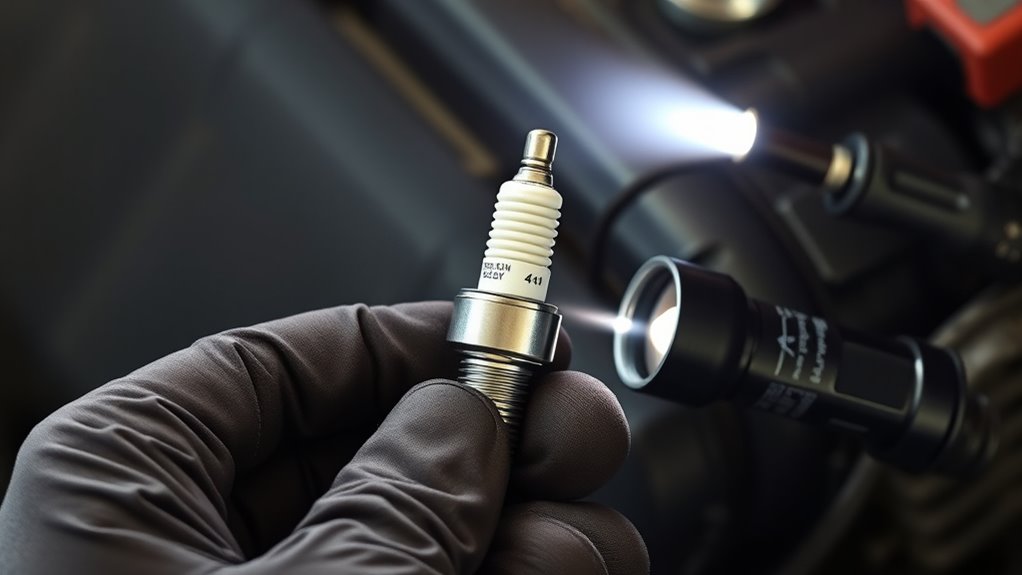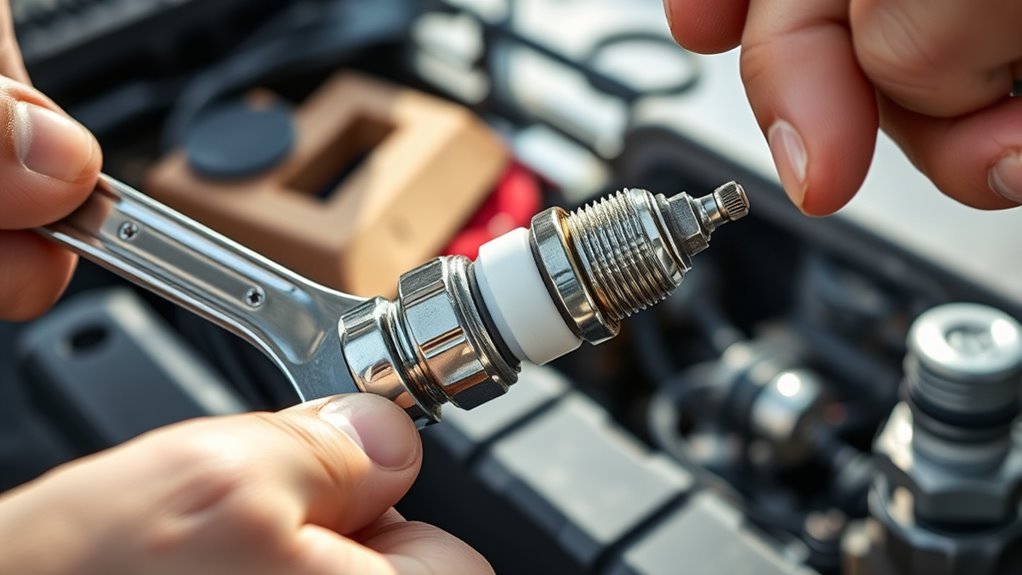To master spark plug basics and troubleshooting in a weekend, start by understanding their role in engine performance and common symptoms like misfires or rough idle. Gather essential tools, prepare a clean workspace, and learn visual inspection techniques for wear or deposits. Practice removing, cleaning, and correctly gapping spark plugs to guarantee proper ignition. Regular maintenance tips, like timely replacements and checks, will boost your confidence—keep going, and you’ll uncover more essential tips.
Key Takeaways
- Gather essential tools like a spark plug socket, gap gauge, and wrench to prepare for inspection and replacement.
- Learn to visually inspect spark plugs for signs of wear, deposits, cracks, and proper electrode gap measurement.
- Follow proper removal and installation techniques to avoid damaging spark plugs or engine components.
- Regularly check and adjust spark plug gaps to ensure optimal engine performance and fuel efficiency.
- Recognize early signs of spark plug issues, such as misfires or rough idling, for timely troubleshooting and maintenance.
Understanding Spark Plug Functions and Symptoms of Issues

Understanding how spark plugs work is essential to diagnosing engine problems effectively. Spark plugs are crucial components of your ignition system, creating the spark needed to ignite the fuel-air mixture in your engine cylinders. When they function properly, your engine runs smoothly, and fuel efficiency stays ideal. However, if the spark plugs are worn or dirty, you might notice symptoms like misfires, rough idling, or decreased acceleration. These issues not only affect performance but also lead to poorer fuel efficiency. Recognizing the signs of spark plug trouble helps you pinpoint problems early, saving you time and money. Regular inspection and understanding the role of spark plugs in the ignition system empower you to maintain your engine’s health and ensure it runs efficiently. Additionally, using high-quality spark plugs can improve engine performance and longevity.
Gathering Tools and Preparing Your Workspace
Before you start troubleshooting your spark plugs, gather the necessary tools and set up a clean, organized workspace. You’ll need basic hand tools, a spark plug socket, and possibly a torque wrench. Having a clean surface helps prevent dirt from contaminating spark plug materials or the ignition system. Keep a spark plug gap gauge handy to check gap settings. Organize your tools in a tray or container for easy access. Use proper lighting to spot signs of wear or damage. Here’s a quick tool overview:
| Tool | Purpose |
|---|---|
| Spark plug socket | Remove/install spark plugs |
| Gap gauge | Check spark plug gap |
| Wrench | Tighten or loosen bolts |
| Clean cloth | Wipe debris |
| Magnetic pickup | Retrieve dropped parts |
Preparing your workspace reduces errors and guarantees safer, efficient troubleshooting.
Visual Inspection and Basic Testing Procedures

Starting with a visual inspection allows you to quickly identify obvious issues that could affect your spark plug’s performance. Check the electrode for signs of wear or erosion, which can cause misfires or poor combustion. Look for cracks, deposits, or carbon buildup that may hinder spark creation. Next, perform a gap measurement using a feeler gauge to ensure the electrode gap matches your vehicle’s specifications. An incorrect gap can lead to weak sparks or delayed ignition. If the electrode is worn down or the gap is off, your spark plug won’t fire efficiently. These basic tests help you diagnose common problems early, saving you time and preventing further engine issues. A thorough visual check is a simple yet essential step in mastering spark plug troubleshooting. Understanding AI-driven diagnostics can further enhance your ability to identify issues more accurately.
Removing, Cleaning, and Replacing Spark Plugs

Removing, cleaning, and replacing spark plugs are essential steps to guarantee your engine runs smoothly. Proper maintenance ensures ideal ignition timing and correct electrode gap, which are crucial for efficient combustion. To do this:
- Use a spark plug socket and ratchet to carefully remove the old plug, avoiding damage.
- Inspect the electrode gap with a feeler gauge, adjusting it to match the manufacturer’s specifications.
- Clean the spark plug using a wire brush to remove deposits, ensuring a strong spark.
- Install the new or cleaned plug, tightening it snugly, then reconnect the ignition system. Properly gapped electrodes promote better ignition timing, directly influencing engine performance. Always double-check the electrode gap before installation for reliable results. Additionally, understanding the effectiveness of maintenance can help you optimize your troubleshooting process.
Preventative Maintenance and Troubleshooting Tips

Regular preventative maintenance is key to keeping your engine running smoothly and avoiding costly repairs. Check your spark plugs regularly and ensure they’re properly gapped to maintain ideal ignition timing. Proper ignition timing improves combustion efficiency, which directly boosts fuel efficiency and engine performance. Keep an eye on signs like rough idling, misfires, or decreased fuel economy, as these can signal spark plug issues. Use high-quality spark plugs suited for your vehicle, and replace them according to your manufacturer’s schedule. Clean or replace spark plugs promptly if you notice fouling or wear. Regularly inspecting your ignition system helps prevent misfires and guarantees consistent spark delivery. Additionally, understanding AI’s role in business intelligence can help you better analyze engine performance data for more precise troubleshooting. By staying proactive, you’ll extend your engine’s lifespan and keep it running at peak efficiency.
Frequently Asked Questions
How Often Should I Replace Spark Plugs for Optimal Performance?
You should replace your spark plugs every 30,000 to 50,000 miles, depending on your vehicle and spark plug lifespan. Regularly check your owner’s manual for recommended replacement intervals. If you notice misfires, rough idling, or decreased fuel efficiency, it’s a sign it’s time for a change. Staying on top of replacement intervals guarantees your engine runs smoothly, maintains peak performance, and avoids costly repairs down the line.
Can Wrong Spark Plug Gaps Cause Engine Misfires?
Did you know that incorrect spark plug gaps are a common misfire cause? Yes, wrong spark plug gaps can definitely cause engine misfires because they affect the spark’s timing and strength. When spark plug wear occurs, gaps can widen or narrow, disrupting combustion. Always check and properly gap your spark plugs to prevent misfires and ensure smooth engine performance. Proper maintenance keeps your engine running reliably and efficiently.
What Are Signs of a Faulty Ignition Coil Related to Spark Plugs?
If your ignition coil is faulty, you might notice your spark plug isn’t firing properly. Signs include engine misfires, rough idling, and difficulty starting your vehicle. You may also experience a decrease in fuel efficiency and noticeable engine hesitation. When the ignition coil fails, it doesn’t send a strong enough spark to the spark plug, leading to poor combustion. Check both components regularly to keep your engine running smoothly.
Are There Differences Between Types of Spark Plugs for Various Engines?
Think of spark plugs as musical instruments, each with unique materials like platinum, iridium, or copper, suited for different engines. You’ll notice variations in size, heat range, and design to match engine compatibility. Some engines demand high-performance plugs with durable materials, while others need basic types. By matching spark plug materials to your engine’s needs, you guarantee smooth operation, better fuel efficiency, and long-lasting performance.
How Do Altitude and Temperature Affect Spark Plug Performance?
Altitude effects can cause your spark plugs to misfire because thinner air reduces combustion efficiency. Temperature impact also matters; high temps can lead to fouling, while cold temps might cause poor ignition. To keep your spark plugs performing well, monitor these conditions and adjust your engine’s air-fuel mixture accordingly. Staying aware of altitude effects and temperature impact helps prevent issues and ensures reliable engine performance.
Conclusion
By mastering these spark plug basics this weekend, you’ll not only prevent potential engine issues but also uncover how a simple component can unexpectedly influence your vehicle’s performance. Sometimes, a quick inspection reveals more than you’d expect—reminding us that small details often hold the key to smooth rides. With a little practice, you’ll find that troubleshooting becomes second nature, turning what seems like coincidence into confidence in your automotive care skills.









